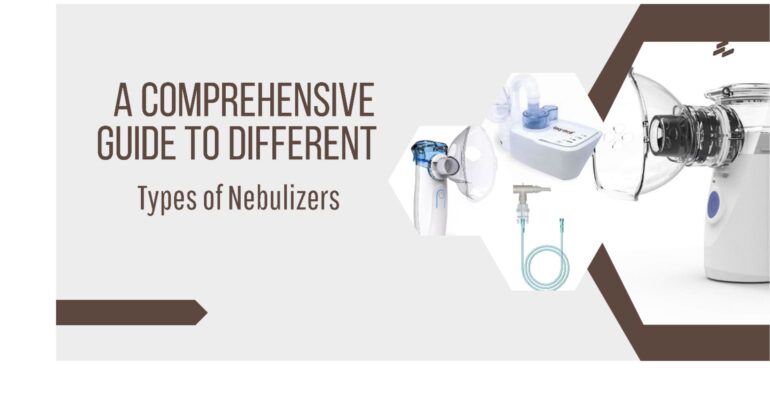“Nebulizer Types : Understanding the Different Types Available”
August 2, 2024 2024-08-02 9:36“Nebulizer Types : Understanding the Different Types Available”

“Nebulizer Types : Understanding the Different Types Available”
Nebulizers are essential devices in the treatment of various respiratory conditions, such as asthma, chronic obstructive pulmonary disease (COPD), and bronchitis. They work by converting liquid medication into a fine mist that can be inhaled directly into the lungs, allowing for quick and effective relief. With several types of nebulizers available on the market, understanding their differences is crucial in selecting the best option for you or your child. The three main types of nebulizers are jet nebulizers, ultrasonic nebulizers, and mesh nebulizers. Each type has its unique features, advantages, and potential drawbacks.
Jet Nebulizers
Jet nebulizers, also known as compressor nebulizers, are the most traditional and commonly used type. They operate by using compressed air to transform liquid medication into an aerosol mist. This process involves a compressor that generates a high-velocity jet of air, which passes through the medication, turning it into tiny droplets suitable for inhalation.
Advantages:
- Affordability: Jet nebulizers are generally less expensive than other types, making them accessible to a broad range of patients.
- Versatility: They can nebulize a wide variety of medications, including those that may not be suitable for ultrasonic or mesh nebulizers.
- Durability: These devices are robust and can handle frequent use, making them a reliable choice for long-term treatment.
Disadvantages:
- Noise: Jet nebulizers tend to be noisy due to the air compressor, which can be disturbing, especially for young children or during nighttime use.
- Bulkiness: They are often larger and less portable than other types, requiring an electrical outlet for operation.
Jet nebulizers are ideal for patients who need a cost-effective and reliable device for home use, especially when noise and portability are not primary concerns.
Ultrasonic Nebulizers
Ultrasonic nebulizers use high-frequency ultrasonic waves to create a fine mist from liquid medication. The ultrasonic waves are generated by a vibrating piezoelectric crystal, which causes the medication to form droplets that can be easily inhaled.
Advantages:
- Quiet Operation: Ultrasonic nebulizers are significantly quieter than jet nebulizers, making them more comfortable to use, especially for children.
- Efficiency: They can deliver medication more quickly, reducing treatment time.
- Portability: Many ultrasonic nebulizers are compact and portable, often powered by batteries, making them convenient for travel and on-the-go use.
Disadvantages:
- Cost: These nebulizers are generally more expensive than jet nebulizers.
- Medication Limitations: Some medications, particularly those with suspensions or high viscosity, may not be suitable for ultrasonic nebulizers due to the heat generated during operation.
Ultrasonic nebulizers are suitable for patients who prioritize quiet operation and portability and do not require medications that are incompatible with this technology.
Mesh Nebulizers
Mesh nebulizers are the most advanced type, using a vibrating mesh to create a fine mist. The liquid medication passes through tiny mesh holes, producing an aerosol that can be inhaled. There are two types of mesh nebulizers: active mesh and passive mesh. Active mesh nebulizers have a vibrating mesh, while passive mesh nebulizers use ultrasonic waves to push the liquid through the mesh.
Advantages:
- Silent Operation: Mesh nebulizers are virtually silent, providing a very comfortable user experience.
- Portability: They are lightweight, compact, and often battery-operated, making them highly portable and convenient for travel.
- Efficiency: Mesh nebulizers are highly efficient, delivering a precise dose of medication with minimal waste.
Disadvantages:
- Cost: These devices are typically the most expensive of the three types.
- Maintenance: Mesh nebulizers require careful cleaning to prevent clogging and ensure longevity.
Mesh nebulizers are ideal for patients who need a portable, quiet, and efficient device, and are willing to invest in a higher-cost option.
Choosing the Right Nebulizer
When selecting a nebulizer, consider the following factors:
- Medical Needs: Consult with your healthcare provider to determine which type of nebulizer is compatible with your prescribed medications.
- Portability: If you need a nebulizer for travel or frequent use outside the home, consider ultrasonic or mesh nebulizers.
- Noise Sensitivity: For young children or those sensitive to noise, ultrasonic and mesh nebulizers offer quieter operation.
- Budget: While jet nebulizers are more affordable, they may not provide the same level of convenience and comfort as ultrasonic or mesh nebulizers.
Conclusion
Understanding the different types of nebulizers—jet, ultrasonic, and mesh—allows you to make an informed decision based on your specific needs and circumstances. Each type has its strengths and weaknesses, from the affordability and versatility of jet nebulizers to the quiet operation and portability of ultrasonic and mesh nebulizers. By considering factors such as medical requirements, portability, noise level, and budget, you can select the nebulizer that best meets your needs, ensuring effective and comfortable respiratory treatment. Always consult with your healthcare provider to ensure the nebulizer you choose is suitable for your prescribed medication and overall treatment plan.



